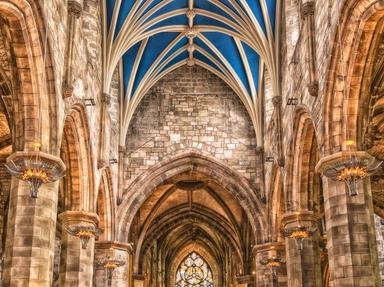Quiz Answer Key and Fun Facts
1. The first cathedral we are going to visit took a whopping 632 years to complete. Situated on the Rhine river, it has been built in Gothic style. Which German city is it in?
2. Let's move a bit north, to Denmark to be exact. One of the first churches in Scandinavia to be built of brick, our next site is also home to the mausoleum of the Danish Royal family. Which cathedral are we looking at?
3. Staying in Scandinavia, we move across the border to Sweden, to a village named Gammelstad. Its church is a normal parish church, not a cathedral, but still of cultural importance since its construction influenced the entire village. In which way was this village special in the centuries following the church construction?
4. Moving southeast, we arrive in Poland. There, we can visit the Jawor and Oewidnica churches, two 17th century timber-framed constructions of quite substantial size, in fact the largest ones in Europe. These churches have a special designation, what is it?
5. Part of the Kremlin in Moscow, Russia, St. Basil's Basilica is one of the greatest churches of the Russian Orthodox confession. It is however not the only cathedral located in the Kremlin. Which of the following is NOT a designation of a church in the Kremlin?
6. Moving along on our tour, we approach Italy. However before we get there, we pass a few other countries. Which of these did not have at least one church or group of churches specifically dedicated as a UNESCO World Heritage site by 2011?
7. It would be impossible to highlight just one of Italy's cathedrals, so let's look at some smaller places of worship. Built in the 15th and 16th century, the Sacri Monti of Piedmont and Lombardy encompass nine hills on which several chapels and other places of worship were erected, blending with their natural surroundings. What motivation was the primary reason for their construction?
8. The monastery of the Escurial (also spelled El Escorial) near Madrid, Spain, is associated with the palace of the Spanish King. It is also the burial site of the Spanish Royal family. Which monastic order is it associated with today?
9. Together with a bridge and a palace, the cathedral of Avignon in France form an important World Heritage site with ties to 14th century European history. Whose palace is part of this complex?
10. We began our journey in Germany and shall end it there as well with a building that has actually never been dedicated as a church but is still inextricably linked with the history of Christianity in Europe as a place of a great religious work. Which of the following buildings fits this description?
Source: Author
WesleyCrusher
This quiz was reviewed by FunTrivia editor
stedman before going online.
Any errors found in FunTrivia content are routinely corrected through our feedback system.
